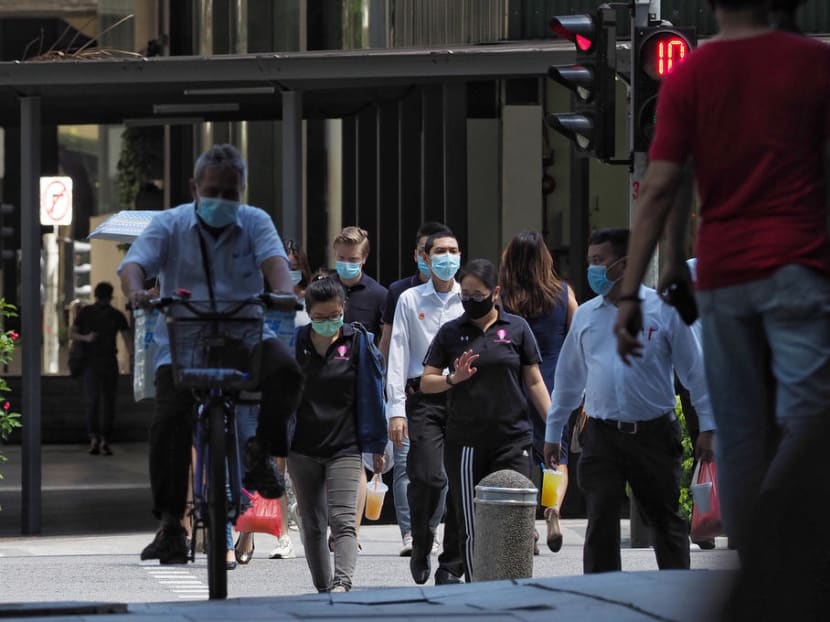Singapore’s unemployment rate dips for fourth straight month in February
SINGAPORE — Unemployment here declined for the fourth consecutive month in February after peaking last September, Manpower Minister Josephine Teo said on Wednesday (April 7).

Unemployment in Singapore fell across the board in February, the Ministry of Manpower said on April 7, 2021.
- The unemployment situation here has continued to improve, with declines seen across the board
- The overall unemployment rate dipped slightly from 3.2 per cent in January to 3 per cent in February
- There were 96,800 residents who were jobless in February, including 85,900 citizens
- Economists expect a more pronounced improvement in the second half of the year
SINGAPORE — Unemployment here declined for the fourth consecutive month in February after peaking last September, Manpower Minister Josephine Teo said on Wednesday (April 7).
In a Facebook post, Mrs Teo added that joblessness remains elevated and warned that with every dip in the unemployment rate, the next drop in the rate will likely be harder to achieve.
"It depends on whether hiring demand is sustained among employers, and their willingness to look beyond candidates with familiar profiles. The remaining jobseekers, too, may need to consider job roles or sectors they previously did not, and be willing to invest time to reskill."
While the fall in unemployment is an encouraging sign, economists interviewed by TODAY said that they expect a more pronounced improvement in the second half of the year and for unemployment to reach pre-pandemic levels by the middle of next year.
This will be in line with the reopening of the economy and easing of safe-distancing rules, they added.
Declines in unemployment were seen across the board, based on data released by the Ministry of Manpower (MOM) on Wednesday.
The overall unemployment rate, which covers citizens, permanent residents (PRs) and foreigners living in households here, came in at 3 per cent in February, declining slightly from 3.2 per cent in January. It peaked at 3.5 per cent last September.
The rate for residents — made up of citizens and PRs — saw a drop from 4.3 per cent in January to 4.1 per cent in February. This rate peaked at 4.8 per cent last September.
For citizens alone, the unemployment rate dipped from 4.5 per cent in January to 4.3 per cent in February. It peaked at 4.9 per cent last September.
There were 96,800 residents who were jobless in February, including 85,900 citizens.
Mrs Teo noted that unemployment rates have yet to return to pre-pandemic levels, but the Government is seeing “good progress” in terms of jobs growth.
Under the Jobs Growth Incentive, payouts have been made to 27,000 employers who hired 130,000 residents in the first three months of the scheme, she said.
The wage subsidy scheme, launched in August last year to encourage firms to hire more residents due to the fallout from the Covid-19 pandemic, was given an added S$5.2 billion boost in this year’s Budget and extended until September.
Mrs Teo added: "It is encouraging to see that government support for employers to expand local hiring has nudged them to consider a more diverse group of jobseekers.
“This includes those from different sectors, those who were previously not employed, and those aged 40 and above.”
MOM said last month that 27,000 eligible employers hired a median of two residents from September to November last year. This is higher than the median of one resident hired in the same period in 2019.
Nearly six in 10 of the firms hired one to two Singapore workers, while the remaining hired more. Almost all of these firms were small- and medium-sized enterprises (SMEs).
LACK OF FOREIGN TALENT A KEY DRIVER
Economists told TODAY that employers are taking a rather cautious approach when it comes to hiring.
However, measures rolled out by the Government such as the Jobs Growth Incentive and the Place-and-Train programmes, which provide training and salary support to help rank-and-file workers reskill to take on new jobs in different sectors, have incentivised employers to look past the background of jobseekers.
Senior economist Irvin Seah from DBS bank said that the key driver for the increased hiring of the domestic workforce is the reduced accessibility to foreign talents with the borders closed and travel restricted.
However, jobseekers must not think that “they can pick and choose” because the number of job vacancies is still fewer than the number of unemployed persons, Mr Seah said.
He added that employers may still hire foreign talents, especially for highly skilled roles that do not require a physical presence and especially since the Covid-19 pandemic has made remote working the new norm.
And although employers have been incentivised to look to the resident workforce in hiring, Mr Seah said that the challenge is to convert these temporary positions into permanent ones.
“For some employers, on-the-job training can instil stronger employee retention. But there are also employers who want someone who can hit the ground running.”
Maybank Kim Eng's economist Chua Hak Bin said that it is difficult to assess whether workers from hard-hit sectors are being absorbed into other growing sectors just by looking at the unemployment trends.
However, Mr Song Seng Wun, an economist from CIMB Private Banking, said it is likely that many of these workers are taking advantage of this time to reskill and shift their employment to another sector, given the take-up rate of government programmes.
“Our workforce has adapted to what the market needs at this point. As we emerge from the pandemic, we must continue to focus on how we can support local employment and generate more jobs that can be filled with our local workforce,” he added.








